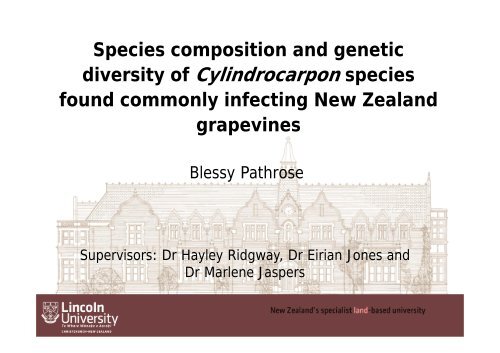diversity of Cylindrocarpon species - Australasian Plant Pathology ...
diversity of Cylindrocarpon species - Australasian Plant Pathology ...
diversity of Cylindrocarpon species - Australasian Plant Pathology ...
Create successful ePaper yourself
Turn your PDF publications into a flip-book with our unique Google optimized e-Paper software.
Species composition and genetic<br />
<strong>diversity</strong> <strong>of</strong> <strong>Cylindrocarpon</strong> <strong>species</strong><br />
found commonly infecting New Zealand<br />
grapevines<br />
Blessy Pathrose<br />
Supervisors: Dr Hayley Ridgway, Dr Eirian Jones and<br />
Dr Marlene Jaspers<br />
23/06/2011 1
Black foot disease <strong>of</strong> grapevines<br />
An important problem in vineyards worldwide,<br />
including:<br />
South Africa<br />
North America<br />
Portugal<br />
Australia<br />
France<br />
Italy<br />
Sicily<br />
New Zealand<br />
It occurs in young vines, mature vines and mother<br />
vines<br />
Disease development is slow, usually in vines < 5 year<br />
old and sometimes in first year <strong>of</strong> planting
Symptoms <strong>of</strong> Black foot disease<br />
Chlorosis<br />
Weak shoot growth<br />
Delayed/absent bud break<br />
Abnormal root<br />
development
Photo by Francois Halleen<br />
Black foot ‐ decline <strong>of</strong> plants
Photo by Francois Halleen<br />
Vascular streaking
<strong>Cylindrocarpon</strong> <strong>species</strong><br />
Causal agents are <strong>Cylindrocarpon</strong> spp.<br />
In all major viticulture regions throughout the world<br />
In New Zealand, 3 <strong>species</strong> are associated with black<br />
foot:<br />
C. destructans C. liriodendri C.macrodidymum
Objective 1: To determine the population<br />
composition <strong>of</strong> <strong>Cylindrocarpon</strong> <strong>species</strong> in NZ<br />
The composition is currently unknown<br />
A 2005 survey <strong>of</strong> NZ vineyards recovered 174 isolates <strong>of</strong><br />
<strong>Cylindrocarpon</strong> <strong>species</strong> from symptomatic vines<br />
Isolates were obtained from the<br />
8 main grape growing regions:<br />
Auckland (14)<br />
Gisborne/Hawkes bay (34)<br />
Martinborough/Nelson/<br />
Marlborough (98)<br />
Waipara, North Canterbury (10)<br />
Otago (18)
Identification <strong>of</strong> <strong>Cylindrocarpon</strong> <strong>species</strong><br />
infecting New Zealand grapevines<br />
Identification by morphological features was insufficient<br />
to differentiate the <strong>species</strong><br />
Process <strong>of</strong> molecular identification<br />
Genomic DNA was extracted from<br />
mycelium
MW C. macrodidymum C. liriodendri C. destructans ‐ve<br />
Amplification with <strong>species</strong> specific primers CymaF1 & CymaR1<br />
Species Specific Primers:<br />
• Lizel Mostert, Stellenbosch University<br />
C. macrodidymum – CymaF1 & CymaR1 = 300 bp<br />
C. liriodendri – CyliF1 & CyliR1 = 200 bp<br />
• Hayley Ridgway, Lincoln University<br />
C. destructans – CydeF1 & CydeR1 = 200 bp<br />
PCR products from the tubulin gene sequenced:<br />
-10% <strong>of</strong> isolates from sp-sp PCR<br />
- 14 unidentified isolates
Objective 2: Characterising genetic <strong>diversity</strong> <strong>of</strong><br />
the three predominant <strong>Cylindrocarpon</strong> spp.<br />
Selection <strong>of</strong> UP-PCR Primers:<br />
• 5 out <strong>of</strong> 11 chosen<br />
• 3 test isolates<br />
• Chosen for # polymophisms & band<br />
distribution<br />
UP-PCR using AA2M2 primer for<br />
C. liriodendri<br />
DNA fingerprints were generated for<br />
151 isolates using UP-PCR:<br />
• C. liriodendri (57) , C. macrodidymum<br />
(41) , C. destructans (53)<br />
Neighbour Joining Tree:<br />
• ~ 70 data points per isolate<br />
• Generated using PAUP s<strong>of</strong>tware<br />
• Identified main genetic groups
Objective 1:<br />
Results<br />
– 41 isolates <strong>of</strong> C. macrodidymum, 57 isolates <strong>of</strong> C. liriodendri,<br />
53 isolates <strong>of</strong> C. destructans were identified<br />
– DNA sequencing confirmed the identification as 100%<br />
accurate for C. destructans, C. liriodendri and C.<br />
macrodidymum<br />
– Unidentified <strong>Cylindrocarpon</strong> spp. were identified as<br />
C. pauciseptatum (9 isolates) Cylindrocladiella parva (1) and a<br />
novel <strong>Cylindrocarpon</strong> <strong>species</strong> (4 isolates)<br />
– 9 isolates remain unidentified
Distribution <strong>of</strong> <strong>Cylindrocarpon</strong> <strong>species</strong> in major<br />
grape growing regions <strong>of</strong> New Zealand<br />
100%<br />
90%<br />
North Island<br />
South Island<br />
<strong>Cylindrocarpon</strong> novel spp.<br />
80%<br />
70%<br />
60%<br />
<strong>Cylindrocarpon</strong> pauciseptatum<br />
<strong>Cylindrocarpon</strong> macrodidymum<br />
50%<br />
40%<br />
<strong>Cylindrocarpon</strong> liriodendri<br />
30%<br />
<strong>Cylindrocarpon</strong> destructans<br />
20%<br />
10%<br />
0%<br />
n= 14 13 21 3 3 95 11 18<br />
Pearson Chi Squared<br />
P= 0.000
Objective 2:C. macrodidymum<br />
• NJ tree produced two<br />
main branches (1<br />
change)<br />
• No clustering by<br />
region, genetically<br />
dissimilar individuals<br />
found at all sites<br />
• Inter – and intra –<br />
vineyard variability<br />
observed<br />
• Clonal isolates were<br />
identified
C. destructans<br />
• NJ tree produced<br />
three main branches<br />
(1 change)<br />
• No clustering by<br />
region, genetically<br />
dissimilar individuals<br />
found at all sites<br />
• Inter – and intra –<br />
vineyard variability<br />
observed<br />
• Clonal isolates were<br />
identified
C. liriodendri<br />
• NJ tree produced six<br />
main branches (1<br />
change)<br />
• No clustering by<br />
region, genetically<br />
dissimilar individuals<br />
found at all sites<br />
• Inter – and intra –<br />
vineyard variability<br />
observed<br />
• Clonal isolates were<br />
identified<br />
• Isolate Ack1b<br />
genetically distinct
Conclusions<br />
• Five <strong>species</strong> <strong>of</strong> <strong>Cylindrocarpon</strong> identified<br />
• Similar frequencies <strong>of</strong> C. macrodidymum (41), C. liriodendri (57) &<br />
C. destructans (53)<br />
• Four isolates <strong>of</strong> a novel <strong>Cylindrocarpon</strong> sp. ,1 isolate <strong>of</strong><br />
Cylindrocladiella parva and 9 isolates <strong>of</strong> C. pauciseptatum identified<br />
• Differences in the distribution <strong>of</strong> the 3 main <strong>species</strong>:<br />
– Higher proportion <strong>of</strong> C. destructans in the South Island<br />
– Higher proportion <strong>of</strong> C. macrodidymum in the North Island<br />
– Proportion <strong>of</strong> C .liriodendri, C. pauciseptatum, novel<br />
<strong>Cylindrocarpon</strong> spp. isolates similar in both Islands<br />
• Populations <strong>of</strong> the three main <strong>Cylindrocarpon</strong> <strong>species</strong> were<br />
genetically diverse with low numbers <strong>of</strong> clonal isolates<br />
• Inter – and intra – vineyard genetic variability observed
Acknowledgements<br />
• Carolyn Bleach – Collecting isolates<br />
• Winegrowers New Zealand –for research<br />
funding<br />
• Lincoln University –for the PhD scholarship<br />
• <strong>Australasian</strong> <strong>Plant</strong> <strong>Pathology</strong> Society –<br />
Sponsorship<br />
• Lizel Mostert, Stellenbosch University<br />
• ICPP –Travel Grant
Chlorosis<br />
Thank You<br />
23/06/2011 18






![[Compatibility Mode].pdf](https://img.yumpu.com/27318716/1/190x135/compatibility-modepdf.jpg?quality=85)









